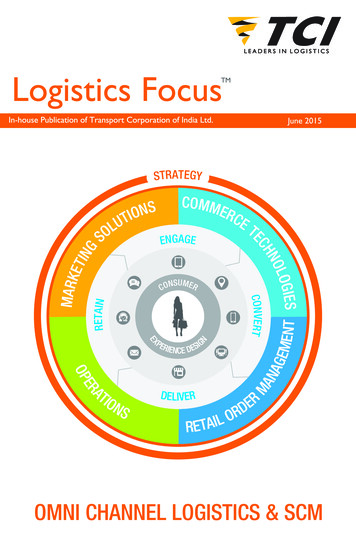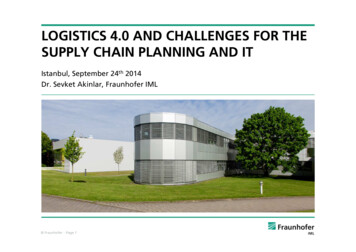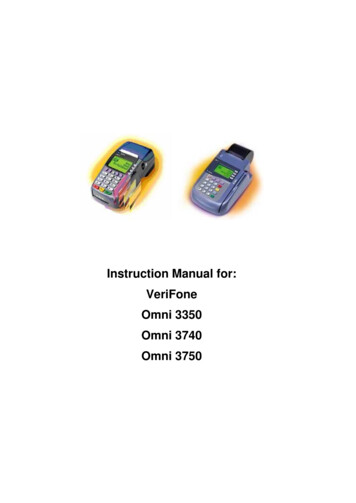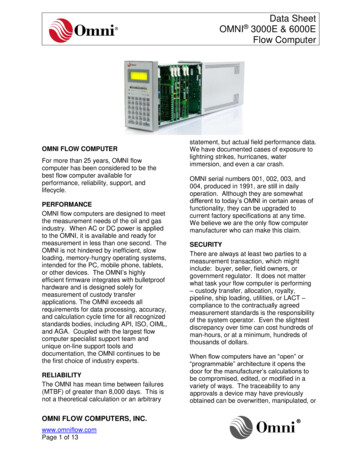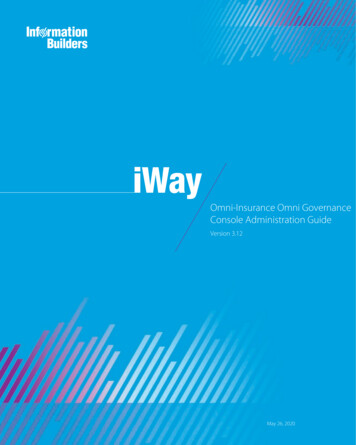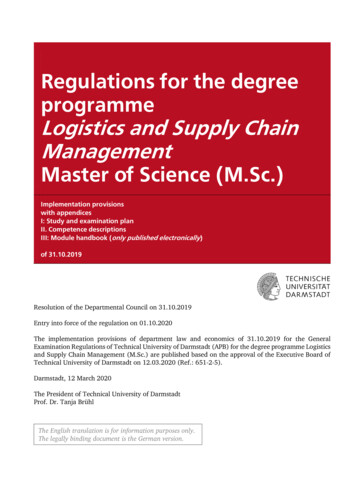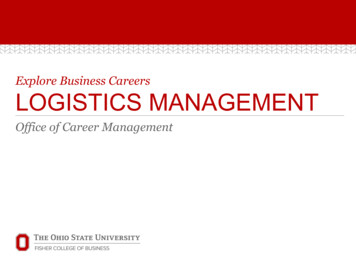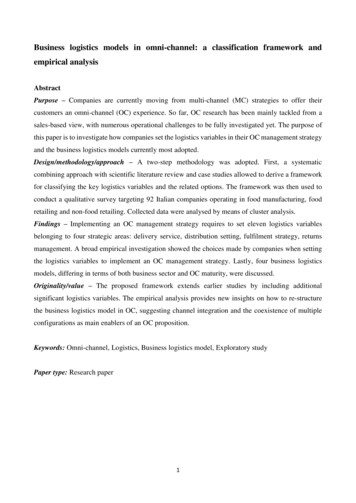
Transcription
Business logistics models in omni-channel: a classification framework andempirical analysisAbstractPurpose – Companies are currently moving from multi-channel (MC) strategies to offer theircustomers an omni-channel (OC) experience. So far, OC research has been mainly tackled from asales-based view, with numerous operational challenges to be fully investigated yet. The purpose ofthis paper is to investigate how companies set the logistics variables in their OC management strategyand the business logistics models currently most adopted.Design/methodology/approach – A two-step methodology was adopted. First, a systematiccombining approach with scientific literature review and case studies allowed to derive a frameworkfor classifying the key logistics variables and the related options. The framework was then used toconduct a qualitative survey targeting 92 Italian companies operating in food manufacturing, foodretailing and non-food retailing. Collected data were analysed by means of cluster analysis.Findings – Implementing an OC management strategy requires to set eleven logistics variablesbelonging to four strategic areas: delivery service, distribution setting, fulfilment strategy, returnsmanagement. A broad empirical investigation showed the choices made by companies when settingthe logistics variables to implement an OC management strategy. Lastly, four business logisticsmodels, differing in terms of both business sector and OC maturity, were discussed.Originality/value – The proposed framework extends earlier studies by including additionalsignificant logistics variables. The empirical analysis provides new insights on how to re-structurethe business logistics model in OC, suggesting channel integration and the coexistence of multipleconfigurations as main enablers of an OC proposition.Keywords: Omni-channel, Logistics, Business logistics model, Exploratory studyPaper type: Research paper1
IntroductionE-commerce sales have grown significantly over the last two decades in all the main markets. Thisdevelopment has progressively induced traditional companies to adopt multi-channel (MC) strategiesand include online sales into their businesses. Originally, a MC strategy involved taking the decisionas to whether new channels should be added to the existing channel mix (Verhoef et al., 2015) and,from an operational viewpoint, companies preferred to keep traditional and online channels apart(Gallino and Moreno, 2014). The individual channels operated in parallel and were uncoordinated(Beck and Rygl, 2015).We are now moving towards a new phase, where technology blurs the distinctions between physicaland online retailing and using diverse channels as a part of the customer’s purchasing process is therule rather than the exception (Brynjolfsson et al., 2013). The recently coined term omni-channel(OC) indicates that, from the customer’s perspective, there is no longer a distinction betweentraditional and online channels (Beck and Rygl, 2015; Verhoef et al., 2015). Differently from a MCcontext, an OC strategy considers the integration of business processes and the synergeticmanagement of multiple channels (Verhoef et al., 2015). Existing studies show that an appropriateintegration of multiple channels leads to a competitive advantage and channel synergies such assales growth, revenue increase rather than channel cannibalisation (Cao and Li, 2015; Herhausenet al., 2015).The achievement of this objective is not straightforward. The challenge faced by companies inimplementing an OC management strategy is to figure out how to integrate and coordinate operationsof traditional and online channels in order to offer a seamless customer’s experience regardless of thechannel (Bell et al., 2014). As such, a certain company may have reached a certain ‘OC maturity’ sofar, that means a certain ability to integrate and coordinate operations among channels and, thus, acertain ability to provide customers a seamless shopping experience – as shown by several industryreports such as Omni-channel Capability Index by IBM (2015) and Global Omni-channel Retail Indexby PwC (2015).From an operations perspective, new cost-efficient business logistics models must be developed tosupport such transitional process (Bell et al., 2014), where the key aspect is the integration of differentchannels. In channel integration, investments are required and issues such as product availability,returns, delivery options and inventory management across the channels need to be addressed(Piotrowicz and Cuthbertson, 2014). Channel integration can occur in a variety of distribution and ITsystem configurations (Gallino and Moreno, 2014). Companies may use their existing resources (e.g.facilities, personnel) for serving both traditional and online channels or else decide on resourcesdedicated to the new channel, possibly with a shared information management. Additionally, such2
type of decisions requires addressing several operational problems, such as capacity management(Xie et al., 2014; Hübner et al., 2015), and can be differentiated by product type or customer’ssegment (e.g. Laseter et al., 2006). We can also expect different business logistics models supportingcompanies at different stages in their implementation process of an OC management strategy.In recent years, the research community has expressed increasing interest in designing businesslogistics models in MC, and OC promises to be an exciting research stream for the near future (Hübneret al., 2016c). Most existing studies on MC are modelling-based contributions, i.e. based onsimulation or analytical models (Alptekinoğlu and Tang, 2005; Bretthauer et al., 2010), whileconceptual or empirical studies have rarely been proposed (De Koster, 2003; Lang and Bressolles,2013). Furthermore, such contributions often concentrate on specific logistics sub-problems, such aspicking location, inventory integration, delivery mode (Bendoly et al., 2007; Bhatnagar and Syam,2014), with limited attempts to integrate the different sides of the subject (Hübner et al., 2016b;Hübner et al., 2016c). Additionally, the empirical evidence provided so far relates to a very smallnumber of countries, without offering quantitative analyses, and presents just an early discussion onthe development process of an OC management strategy (France in Lang and Bressolles, 2013;Germany in Hübner et al., 2016c).Given such an evolving landscape towards OC and the current state-of-the-art, the aim of the presentpaper is two-fold: (i) to provide a broad empirical investigation of the choices made by companieswhen setting the logistics variables, and (ii) to identify the business logistics models currently adoptedby companies, highlighting the main enablers of an OC proposition. To achieve these objectives, aframework for classifying and describing the key logistics variables is defined. We extended theframework proposed by Hübner et al. (2016b), performing a comprehensive review of the existingliterature and three case studies, representative of Italian market. Such framework was used as astarting point for the empirical investigation based on a sample of 92 Italian-based leading companiesselling products both online and through traditional channels.The remainder of the paper is organised as follows. The next section provides a summary of thesignificant literature in this field. Then, the research questions and methodology are described, andthe research framework is illustrated. In the final sections, the results are discussed and conclusionsare drawn, identifying the research limitations and proposing the directions for future research.Literature reviewMain logistics issues in multi-channelThe existing research stream on MC retailing mostly focuses on the specific logistics variables thatcompany managers must handle when operating in such a context. For instance, when implementing3
a business logistics model in a MC environment, a first strategic area is the distribution networkdesign. A key variable is the number and types of logistics facilities that companies selling productsonline and through traditional channels use to handle online orders (Alptekinoğlu and Tang, 2005;Bendoly et al., 2007; Bretthauer et al., 2010). For a company, the decision of whether to use stores ordistribution centres (DCs) that also serve the traditional channel or dedicated distribution centres isrelated to online market size (De Koster, 2003; Bendoly et al., 2007), correlation between online andtraditional demand (Alptekinoğlu and Tang, 2005) and transport costs (Liu et al., 2010). As anexample, Bretthauer et al. (2010) developed a model to identify the optimal number of logisticsfacilities that the company needs to fulfil online orders while minimising logistics costs.Another strategic area for companies operating in a MC environment consists in inventorymanagement. For instance, the benefits of pooling online and traditional channel inventories havebeen covered in many studies (Chiang and Monahan, 2005; Schneider and Klabjan, 2013), as well asproduct availability issues (Bendoly et al., 2005; Fernie and Grant, 2008). More recently, someauthors have addressed the problem of allocating online orders, proposing dynamic allocation policiesas an alternative to traditional static allocation (Mahar and Write, 2009; Mahar et al., 2009).Another strategic area that emerged is delivery service. One of the main challenges in e-commerce istypically the ‘last mile’, i.e. home delivery (HD) (Punakivi et al., 2001). HD can be ‘attended’, whenthe consumer is there to receive delivery, and ‘unattended’, when the customer is not required to bepresent for the delivery (Kämäräinen and Punakivi, 2002). Although unattended delivery increasesflexibility, it can only take place when goods can be left safely, for example in the customer’sletterbox (Agatz et al., 2008), and customers are willing to accept this type of delivery. Examiningattended HD, many studies focus on time slot management (Punakivi and Saranen, 2001; Agatz etal., 2011) and some authors have recently addressed the problem of differentiated time slot pricing(Klein et al., 2017). Many contributions have also analysed the option as an alternative to HD forcustomers to collect goods bought online from a specific location, such as a locker or shop (Mahar etal., 2012; Wang et al., 2014).Lastly, several contributions relate to returns management. The online channel is defined by its highreturns rate (Bernon et al., 2016). Suitable reverse logistics operations are needed for collecting,checking, repackaging and redistributing the returned goods (Fernie and Sparks, 2014). Looking atthe collection process, returned goods can be managed through dedicated facilities or traditionalstores (Fernie and Sparks, 2014; Widodo et al., 2011).4
Business logistics models in omni-channelIn the extant literature, only few papers adopted a comprehensive perspective in addressing the keystrategic areas and variables involved when implementing a business logistics model in companiesselling products both online and through traditional channels.We found two literature reviews that gave an overview of the significant logistics variables requiredin this case and provide a summary of the studies in literature. Swaminathan and Tayur (2003)described five strategic areas that have increased in importance with the emergence of e-commerce(procurement and supplier selection, visibility and information sharing, distribution and pricing,customisation and postponement and decision technology). They argued that companies need to adapttheir supply chains to the e-commerce environment, with investments along the supply chain toexploit the benefits of the new channel, and they highlighted the growing need for models to evaluatethe impact of changing one or more elements in the supply chain (e.g. inventory, lead time, capacity).Agatz et al. (2008) illustrated the main logistics variables relating to e-fulfilment in MC, structuredinto two strategic areas (sales and delivery planning and supply chain management). They argued thatMC business logistics models can be used to serve different customer’s segments, creating synergiesand exploiting economies of scale, and they recognised that the interplay between online andtraditional channels with regards to logistics is a broad area of research opportunities. Although thesereviews represent the first effort to summarise the main logistics variables involved in setting up aMC business logistics model and do offer some insights into the interaction between multiplechannels, the focus is on modelling-based papers, which generally do not consider the integrationbetween online and traditional channels in an OC perspective.Similarly, some authors have proposed comprehensive frameworks involving the key logisticsvariables for MC companies, using empirical analyses to examine their interdependencies. Lang andBressolles (2013) identified four e-fulfilment models in MC retailing, looking at the facility in chargeof the order (DC or store) and the delivery mode (HD or in-store pickup). They discussed these modelsand their performance with eight French retailers. Hübner et al. (2015) identified four main strategicareas in MC retail (network design, warehouse operations, inventory management and capacitymanagement) and explored the interdependences among them, identifying and discussing thedifferent options for each strategic area.More recently, with the advent of the new OC approach, some authors have proposed researchframeworks focused on how multiple channels can be synergistically managed to provide a seamlessshopping experience. In this line, Hübner et al. (2016a) described the forward and the backwarddistribution systems in OC retailing, considering the sources (supplier DCs, retailer DCs, stores) andthe destinations (home, store). They illustrated advantages and disadvantages of the various design5
solutions and presented the challenges for integrating online and traditional channels. Hübner et al.(2016b) developed a framework for last mile order fulfilment and delivery in OC food retailing, basedon explorative interviews with retailers and experts in the grocery industry. According to thisframework, logistics variables (picking location, picking automation, picking integration, deliverymode, delivery time, delivery area and returns) are organised around two strategic areas, back-endfulfilment and last mile distribution. They identified different design parameters for each area anddiscussed how design choices vary according to retailer specifics (e.g. current market position),country features (e.g. population density) and customer behaviour (e.g. willingness to pay for HD).So far, the academic literature has mainly focused on both describing the different options for channelintegration and assessing pros and cons of individual options. In the last few years, some attemptswere made to study the development process of an OC management strategy. In this line, Hübner etal. (2016c) highlighted the concept of OC maturity, by investigating the transition from MC to OCretailing through an exploratory survey that involved over 60 German retailers and experts. Theyempirically showed that retailers evolve from using separate inventory systems to channel-integratedinventories, with one common picking zone. This solution also means that inventory allocation shouldbe flexible and demand-driven. Concerning the forward and backward distribution, Hübner et al.(2016c) argued that retailers introduce in-store pick-up and return option besides the postal service.At last, the integration at both organisation and IT systems levels is an enabler for an OC managementstrategy. Saghiri et al. (2017) developed a conceptual framework for formalising the meaning ofintegration in OC based on three dimensions: channel stage, channel type and channel agent. Theyidentified integration and visibility as the main enablers of OC management strategies and theirimplementations, where, from an operational perspective, integration refers to synchronisedprocesses and decisions among different channels. Lastly, some attempts to analyse the OC strategyadopted by companies operating in different countries and sector segments are provided by severalindustry reports (e.g. PwC, 2015). In particular, the Omni-channel Capability Index by IBM (2015)aims at measuring the OC maturity in different business sectors by comparing the retailers’ OCcapabilities also from an operational perspective (capability of offering the same day delivery, onlineinformation on product availability in store, in-store pick-up and return).Research questionsThe literature review has revealed a number of logistics variables involved in implementing abusiness logistics model in OC that relate to different strategic areas (e.g. distribution network design,inventory management, delivery service, returns management). With reference to the OCenvironment, the most significant contributions seem to be those by Hübner et al. (2016b) and Hübner6
et al. (2016c), who analysed the issue empirically and tried to integrate the different sides of thesubject. However, these studies do not provide a comprehensive overview of the logistics issuesinvolved in OC. For instance, transport is not considered as a key issue when defining the businesslogistics model, although it is a major area for synergy in implementing an OC approach.Furthermore, empirical studies have rarely been proposed on how companies set the logisticsvariables in implementing their OC management strategy. The few contributions available inliterature focus on retailing without comparing various business sectors. Owing to an evolvingbusiness landscape in transition from MC to OC, a number of additional key elements need to beconsidered to help companies define their business logistics model.Based on this premise, the following research questions (RQs) were identified:RQ1: How do companies implementing an OC management strategy set the logistics variables?RQ2: What are the business logistics models (as a combination of the logistics variables) currentlyused by companies implementing an OC management strategy?As suggested by previous literature (PwC, 2015; Hübner et al., 2016c), different business sectors aretypically characterised by different OC maturity. Thus, to capture the variety of business models wedecided to analyse companies operating in three different business sectors, i.e. food manufacturing,food retailing and non-food retailing. Specifically, we selected non-food retailing as, according to thelast report provided by the Observatory for eCommerce b2C of Politecnico di Milano, it was the firstbusiness sector to be faced by e-commerce sales in Italy, and food retailing that is currently at unrest,with the most important yearly growth rate in 2017 (i.e. 43%). Then the analysis was extended tomanufacturers, specifically food manufacturers, since more and more companies are adding theonline channel to their traditional business aiming at providing an OC experience, and very fewcontributions have been provided so far on this topic in the existing literature (Xie et al., 2014).Research methodologyAs suggested by similar studies available in literature (Marchet et al., 2017), a two-phasemethodology was adopted, as illustrated in Figure 1. In the first phase, we defined the researchframework to address our research questions, whereas in phase two we provided empirical insightson business logistics models adopted by companies in implementing their OC management XXXXXXXXXXXXXXTake in Figure XXXXXX7
Phase 1: framework developmentTo develop the research framework, a ‘systematic combining approach’ was applied. Systematiccombining is a process whereby theoretical framework, empirical fieldwork and case analysis evolvesimultaneously, and it is particularly useful in the refinement of existing theories (Dubois and Gadde,2002). The process started by reviewing the literature on the topic to identify the main logisticsvariables that companies developing an OC strategy set, as well as their corresponding options. Thisstep produced an initial framework describing the logistics variables that companies take into accountwhen operating in an OC environment based on the available literature. Three case studies were thenconducted to adjust the framework by including the industrial viewpoint. The sample selection wasbased on a theoretical sampling to collect information supporting the development of the framework.Specifically, the cases targeted companies that pioneered the Italian e-commerce market and whosecurrent e-commerce market share in Italy is over 40% in their respective sector. Moreover, we lookedfor companies belonging to business sectors characterised by different OC maturity (foodmanufacturing, food and non-food retailing), with a broad visibility on OC projects worldwide andthat have performed detailed analysis when setting their business logistics models. The respondentswere Supply Chain or Logistics directors in order to have a broad and strategic perspective on the efulfilment operations. The questions were submitted to the interviews in advance and then phoneinterviews were arranged in the length of one to two hours. The focused interview format in whichthe interviewer follows a set of predetermined questions was used. Even so, the interviews remainedfairly open-ended to allow the interviewees to express their opinions and experience into certainissues. In addition, secondary data were collected from company website, company reports andpublished information to provide background and context for the primary research data gathered fromthe interviews. The interviews were transcribed, integrated with secondary materials and jointlydiscussed by four researchers. The key outcomes of this process were as follows. On the one hand,the cases confirmed the logistics variables that had emerged from the literature and, on the other, theyhelped identify several additional significant elements that had not been included previously and/orallowed us to slightly modify some existing ones. Furthermore, the cases allow to accumulatecontextual knowledge to facilitate the second phase in terms of both data collection and analysis. Theinitial framework was successively modified following the empirical findings and the theoreticalinsights gained during the process.Phase 2: empirical analysisIn phase two, an exploratory qualitative survey was conducted. A qualitative survey is a method fordefining and investigating variation in populations. It is used to determine the diversity among some8
topics of interest within a given population and establish the meaningful variations within thatpopulation, without inferring any statistical representation (Fink, 2003; Jansen, 2010). The unit ofanalysis was the single company operating in Italy in an OC environment, capturing the businesslogistics model adopted by each. Our sample consisted of 92 Italian companies, i.e. 57 foodmanufacturers, 13 food retailers and 22 non-food retailers. We selected these companies starting fromthe AIDA-Bureau Van Dijk database, considering a company annual revenue threshold over 50million for food manufacturers and over 100 million for food and non-food retailers and, then,filtered the dataset to consider only those companies with e-commerce operations. Tables 1 and 2present an overview of the selected sample in terms of company turnover and company size expressedas number of employees, XXXXXXXXXXXXXXXXXXTake in Table XXXXXXXXXXXTake in Table XXXXXXFollowing Marchet et al. (2017), semi-structured interviews were employed to explore the answersdeemed as most interesting, collect insights and examples and ensure a rounded understanding of thedata. The 92 selected companies were contacted by e-mail to ask whether they could be interviewed,with a cover letter explaining the purpose of the research. Interviewees were identified from adatabase supplied by the Observatory Contract Logistics of Politecnico di Milano that containscontact information of about 600 Supply Chain or Logistics directors and about 150 logistics serviceproviders (LSPs) operating in different sectors. Based on the companies’ availability, the intervieweeswere senior managers working either for the company itself (57 interviews) or for its LSP (9interviews). LSPs were asked to fill different questionnaire forms, one for each of their customers.Two different versions of the questionnaire were developed around the interviewee type (companymanager or LSP), each with three main sections. Section 1 gathered general information about thecompany (e.g. annual revenue, % e-commerce turnover/overall company turnover). Section 2contained questions about its traditional channel logistics (e.g. number of levels in the network,number of stores) and section 3 investigated the company business logistics model for its onlinechannel (options adopted for each identified logistics variable). The interviews lasted around an hour9
and were meant so that cross-case comparisons were possible. Secondary data were also collectedfrom company website, company reports and published information.Collected data were first analysed through simple descriptive statistics, discussing how companiesset the logistics variables (RQ1). Second, the business logistics models (RQ2) were identified bymeans of a cluster analysis performed in Minitab 17. The logistics variables illustrated in the researchframework were considered as input/predictor factors, each forming a nominal attribute with two ormore categories. Note that for each variable with multiple responses allowed we introduced thecategory ‘multiple options’, used for companies adopting more than one option (e.g. companies usingboth HD and click and collect – C&C – as delivery mode). Clusters were formed based on differencesand similarities between observations and the Ward’s method was used. Specifically, considering thetype of attributes (i.e. nominal attributes) the similarity between a pair of observations was definedintroducing the distance measured as (𝑛 𝑓) 𝑛, where 𝑛 denotes the total number of attributes and𝑓 denotes the number of attributes for which the two observations have the same nominal value.Subsequently, a profile of the clusters was developed by introducing the business sector factor. ThePearson Chi-Squared test was used to check statistically significant difference among the companygroups regarding the business sector factor.Research frameworkThis section illustrates the resulting framework to describe and classify the logistics variables thatcompanies operating in an OC environment set. As previously stated, this framework was builtstarting from the earlier study by Hübner et al. (2016b) and was revised and expanded through acomprehensive review of the existing literature and three case studies. The framework is structuredaccording to the four main areas that refer to company strategic decisions: delivery service,distribution setting, fulfilment strategy, returns management. Once the front-end process (marketingstrategy regarding price policy and assortment for the online channel) has been defined, the companystructures a coherent offer in terms of servicing the online channel and forward distribution system,followed by defining the backward distribution system for goods returned. Each strategic areaincludes different logistics variables representing the design parameters to be implemented, withmultiple options available for each variable.Figure 2 reports the resulting framework. The individual logistics variables and corresponding optionsare described below, whereas Table 3 summarises the contribution of literature and case studyanalysis to the XXXXXXXXXXXXXXX10
Take in Figure XXXXXXXXXXXTake in Table XXXXXXDelivery serviceCompanies operating in an OC environment need to consider four main logistics variables relating tothe delivery service: delivery mode, velocity, time slot and slot price differentiation.The delivery mode is a key logistics variable for the online channel, as it is the final part of the orderprocess. According to the extant literature (Lang and Bressolles, 2013; Hübner et al., 2016c),companies can decide between two main options: HD and C&C. In turn, the former can be attendedHD or unattended HD, while the latter is when customers collect their goods at a given pick-up point,which can be a retailer store (in-store C&C), a drive-through centre near a retailer store (attachedC&C), a locker or locations such as a post office (solitary C&C). From the customers’ perspective,the delivery mode is mainly a matter of their preference and access to available pick-up points(Nilsson et al., 2015). From the company perspective, the delivery mode affects logistics (for HD,goods are transported by courier; for in-store C&C, they may travel with the goods delivered tostores).Delivery velocity is one of the most highly visible service elements and heavily depends on theindustry (product type and customer’s requirements). In line with previous contributions (Hübner etal. 2016b), the options can be same day, next day and two or more days. A short lead time to fulfiland deliver an order implies, for instance, to set the picking location very close to the customer.Aligned to the extant literature (Hübner et al. 2016b), the time slot can be specific or undefined. Theformer
reports such as Omni-channel Capability Index by IBM (2015) and Global Omni-channel Retail Index by PwC (2015). From an operations perspective, new cost-efficient business logistics models must be developed to support such transitional process (Bell et al., 2014), where the key aspect is the integration of different channels.

